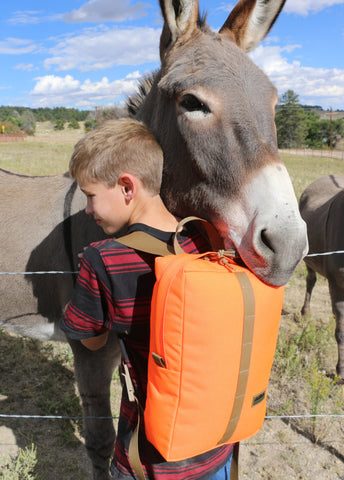I was in the back-country on an archery elk hunt. (It seems like a lot of my stories start out this way.) My burros were in their portable corral when a couple of horse riders rode by my camp. I had left a few minutes before and was about 1/2 mile away headed out for my afternoon hunt. I could see them down the valley and could hear them talking but I couldn’t make out what they were saying. Then I heard the laughter, so loud that it echoed down the valley. It was obvious, they were laughing at my burros.
Throughout history burros have been ridiculed, looked down upon and abused. It is hard for me to understand because they have played such an important part in the establishment of our civilized society. For example, it was donkeys that helped the Israelites when they wandered in the desert for 40 years. Donkeys were also the main workforce in building the pyramids of Egypt. Greeks, Romans and early Europeans relied on donkeys to haul food, water, war supplies and cultivate fields. In the US donkeys and mules were instrumental in opening up the west. There are numerous stories about how burros saved the lives of the early Colorado pioneers and prospectors. They helped them find their way when they were lost or took them to water when they were dying of thirst in the deserts of the Southwest. You wouldn’t know this by watching western movies. Cowboys always seem to be seated on a handsome steed. However, this is not historically accurate, in reality early pioneers preferred Spanish Mules over horses.
William Henry Jackson, surveyor, circa late 1800's
William Henry Jackson, surveyor, circa late 1800’s
The Lone Ranger would have looked pretty silly riding a little white donkey. Let’s face it, a beautiful horse with a flowing mane and tail is an appealing image. It’s hard for a donkey to pull that off. That could be one of the reasons donkeys are looked down upon, because they do not have the “curb appeal” of a horse. Their shaggy coat, long ears and spindly tails make it easy for people to poke fun at them. Donkeys might not have the rippling muscles and silky coats of a horse but I find them cute as a button. That is why it seems so odd that such a cute animal can make such an outrageous sound! The bray of a donkey always brings a smile to people’s faces but for some the sound only adds to their disdain for the donkey. Here in Colorado, after the mines closed and roads were built, donkeys were no longer needed and set loose to fend for themselves. There were so many hanging around the mountain towns and their brays were so raucous they were affectionately (or not so affectionately) known as Rocky Mountain Canaries.
Economics has also played a part in the negative connotation given to donkeys. When the Hebrews were made slaves they brought their donkeys to help them in their toil for the Pharaoh. Thus began the association of the ass with slavery, the under privileged and the marginalized. In Europe and America those who could not afford a strong horse in the 1800’s and early 1900’s used donkeys and mules. Because of this they were further associated with poverty. To this day, donkeys are still associated with the poor.
Some time after my elk hunt, and by chance, I was introduced to the ladies who had stopped and laughed at my burros. After a bit of conversation I asked one of them what she found so funny when she stopped to look at my pack animals. She explained that as a child the first animal she learned to ride was a little donkey. Seeing my two burros caused her to recall fond childhood memories. So much so, as she told her riding companion a few stories it brought out heartfelt laughter. Her respect and love of donkeys was still strong and to my relief she was not laughing at them, she was reliving the joy they had brought her all those years ago.
Tags
- American Made
- Backcountry
- Backcountry Adventure
- Backpacking
- Backpacks
- Bowhunt America
- Burro
- Burro Pannier
- Burros
- Camping
- Colorado
- Dana Rogers
- Day Hikers
- Day Pack
- Deer Hunting
- Donkey
- Elk Hunting
- Equine Riding
- Equine Training
- First Elk
- Hiking
- Hunting Equipment
- Hunting Gear
- Hunting Paniers
- Hunting Panniers
- Hunting Season
- Hunting Skills
- Hunting Supplies
- Jake Clark's Mule Days
- MRG
- Mule
- Mule Days
- Mule Deer
- New Mexico Elk Hunt
- Original ATV
- Outdoor Gear
- Outdoor Skills
- Outdoors
- Pack Animal
- Pack Animals
- Pack Equipment
- Pack Mule
- Pack Saddle
- Packing Equipment
- Packing Supplies
- Packing Tips
- Panniers
- Rockies
- Rocky Mountains
- Saddle Bags
- Saddle Mule
- Saddling
- Steve Edwards
- Trail Etiquette
- Trail Riding
- Western Riding Saddles
- Wilderness



